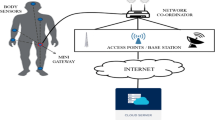Abstract
This study concerns security issues of the emerging Wireless Body Sensor Network (WBSN) formed by biomedical sensors worn on or implanted in the human body for mobile healthcare applications. A novel authenticated symmetric-key establishment scheme is proposed for WBSN, which fully exploits the physiological features obtained by network entities via the body channel available in WBSN but not other wireless networks. The self-defined Intrinsic Shared Secret (ISS) is used to replace the pre-deployment of secrets among network entities, which thus eliminates centralized services or authorities essential in existing protocols, and resolves the key transport problem in the pure symmetric-key cryptosystem for WBSN as well. The security properties of the proposed scheme are demonstrated in terms of its attack complexity and the types of attacks it can resist. Besides, the scheme can be implemented under a light-weight way in WBSN systems. Due to the importance of the ISS concept, the analysis on using false acceptance/false rejection method to evaluate the performance of ISS for its usage in the scheme is also demonstrated.
Similar content being viewed by others
References
A. Menezes, P. van Oorschot, S. Vanstone. Handbook of Applied Cryptography. Florida, USA, CRC Press, 1996, 489–533.
R. M. Needham, M. D. Schroeder. Using encryption for authentication in large networks of computers. Communications of the ACM, 21(1978)12, 993–999.
R. H. Deng, L. Gong, A. A. Lazar, et al. Authenticated key distribution and secure broadcast using no conventional encryption: A unified approach based on block codes. Proc. of IEEE Globe Telecommunications Conference, Singapore, Nov. 13–19, 1995, vol.2, 1193–1197.
Q. Huang, J. Cukier, H. Kobayashi, et al. Fast authenticated key establishment protocols for self-organizing sensor networks. Proc. of the 2nd ACM International Conference on Wireless Sensor Networks and Applications, San Diego, USA, Sept. 19, 2003, vol.2, 141–150.
M. Abdalla, P. A. Fouque, D. Pointcheval. Password-based authenticated key exchange in the three-party setting. IEE proceedings, 153(2006)1, 27–39.
K. Imamoto, K. Sakurai. Key-exchange protocol using pre-agreed session-ID. Proc. of 5th International Workshop on Information Security Applications, Jeju Island, Korea, Aug. 23–25, 2004, 375–387.
S. Capkun, L. Buttyan, J.P. Hubaux. Self-organized public-key management for mobile ad hoc networks. IEEE Trans. on Mobile Computing, 2(2004)1, 52–64.
R. S. H. Istepanian, E. Jovanov, Y. T. Zhang. Introduction to the special section on m-health: beyond seamless mobility and global wireless health-care connectivity. IEEE Trans. on Information Technologies in Biomedicine, 8(2004)4, 405–414.
C. Poon, S. D. Bao, Y. T. Zhang. A novel biometrics method to secure wireless body area sensor networks for telemedicine and m-health. IEEE Communications Magazine, 44(2006)4, 73–81.
S. D. Bao, Y. T. Zhang, L. F. Shen. A design proposal of security architecture for medical body sensor networks. Proc. of International Workshop on Wearable and Implantable Body Sensor Networks, Boston, USA, Apr. 3–5, 2006, 84–90.
U. Uludag, S. Pankanti, S. Prabhakar, et al. Biometric cryptosystems: Issues and challenges. Proceedings of the IEEE, 92(2004)6, 948–960.
Author information
Authors and Affiliations
Corresponding author
Additional information
Supported by the High Technology Research and Development Program of Jiangsu Province (No.BG2005001) and Hong Kong Innovation and Technology Fund (No.ITS/99/02).
Communication author: Bao Shudi, born in 1977, female, Ph.D. candidate, National Mobile Communications Research Lab, Southeast University, Nanjing 210096, China.
About this article
Cite this article
Bao, S., Poon Carmen, C.Y., Shen, L. et al. Authenticated symmetric-key establishment for medical body sensor networks. J. of Electron.(China) 24, 421–427 (2007). https://doi.org/10.1007/s11767-006-0152-z
Received:
Revised:
Published:
Issue Date:
DOI: https://doi.org/10.1007/s11767-006-0152-z
Key words
- Wireless Body Sensor Network (WBSN)
- Network security
- Authenticated key establishment
- Physiological feature




